 W
WAgalychnis callidryas, known as the red-eyed treefrog, is an arboreal hylid native to Neotropical rainforests where it ranges from Mexico, through Central America, to Colombia. It is sometimes kept in captivity. The scientific name of the red-eyed treefrog, A. callidryas, comes from Greek words kalos (beautiful) and dryas.
 W
WAgalychnis saltator is a species of frog in the family Phyllomedusidae. It is found in the Caribbean lowlands from north-eastern Honduras through Nicaragua to east-central Costa Rica at elevations of 15–1,300 m (49–4,265 ft) asl. Its common names are parachuting red-eyed leaf frog and misfit leaf frog.
 W
WAllobates talamancae is a species of frog in the family Aromobatidae. It is found in northwestern Ecuador, western Colombia, Panama, Costa Rica, and southern Nicaragua.
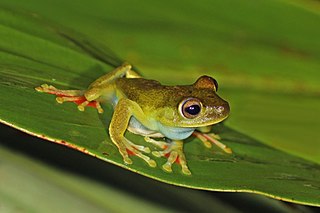 W
WThe Canal Zone tree frog is a species of frog in the family Hylidae found in the Caribbean lowlands of eastern Nicaragua, Costa Rica, and central Panama, as well as the Pacific lowlands of Colombia, although the latter records are uncertain and may refer to Boana rosenbergi.
 W
WCochranella granulosa is a species of frog in the family Centrolenidae. It is found in Costa Rica, Honduras, Nicaragua, and Panama.
 W
WThe Copan stream frog is a species of frogs in the family Hylidae found in Guatemala, Honduras, Nicaragua, and possibly El Salvador. Its natural habitats are subtropical or tropical moist lowland forests, subtropical or tropical moist montane forests, rivers, pastureland, and heavily degraded former forests. It is threatened by habitat loss.
 W
WCraugastor fitzingeri is a species of frog in the family Craugastoridae. It is found in northwestern Colombia, Panama, Costa Rica, eastern Nicaragua, and northeastern Honduras. The specific name fitzingeri honors Leopold Fitzinger, an Austrian zoologist. Common name Fitzinger's robber frog has been coined for this species.
 W
WCraugastor mimus is a species of frog in the family Craugastoridae. It is found in lowland and premontane forests on the Atlantic versant from eastern Honduras through eastern Nicaragua to central Costa Rica. Its natural habitat is lowland and premontane moist and wet forests. It is threatened by habitat loss.
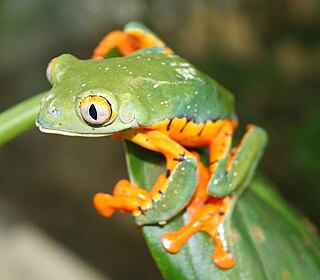 W
WCruziohyla calcarifer, the splendid leaf frog or splendid treefrog, is a tree frog of the family Phyllomedusidae described in 1902 by George Albert Boulenger. It has a distribution from Esmeraldas Province in northwestern Ecuador, through western Colombia and Panama to the most southerly part of Costa Rica. It is a nocturnal, arboreal frog inhabiting primary humid lowland forest.
 W
WDendropsophus ebraccatus, also known as the hourglass treefrog or pantless treefrog, is a neotropical treefrog, found scattered throughout Central and South America from southern Mexico to northern Ecuador. The common names of D. ebraccatus come from the dark hourglass shaped pattern found in the centre of the back and the distinct smooth yellow thighs that contrast the rest of the brazenly patterned body. The contrasting of the smooth yellow thighs from the rest of the bodies pattern provide the illusion that D. ebraccatus is not wearing pants. The name ebraccata in Latin means "without trousers". D. ebraccatus has a number of unique reproductive features, such as the ability to alter rates of hatching shared in a number of Anura families. D. ebraccatus is also extremely unique in its ability to alter its mode of reproduction as it is the only known vertebrate to be able to do so.
 W
WDendropsophus microcephalus is a species of frog in the family Hylidae. It is found in southeastern Mexico, Central America, and northern South America in Colombia, Venezuela, Trinidad and Tobago, the Guianas, and northern Brazil. This widespread species might actually be a species complex. Its common names include yellow treefrog, small-headed treefrog, and yellow cricket treefrog.
 W
WDendropsophus phlebodes, the San Carlos treefrog or San Carlos dwarf treefrog, is a species of frog in the family Hylidae. It is found in western Colombia, Costa Rica, Nicaragua and Panama. Its natural habitats are tropical moist lowland forests, but it may also occur in disturbed habitats. It is threatened by habitat loss.
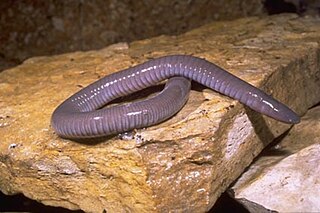 W
WThe Mexican burrowing caecilian is a species of limbless amphibian in the family Dermophiidae. It is found in Mexico and Central America, where it burrows under leaf litter and plant debris.
 W
WDiasporus diastema is a species of frog in the family Eleutherodactylidae. Common names include common tink frog or dink frog, supposedly because of the loud metallic "tink" sound that the male frog makes during the night. It is found in Central America, from Honduras through Nicaragua and Costa Rica to Panama. Its natural habitats are tropical humid lowland forests and montane forests, but it can very disturbed habitats. It is found from sea level to 1,620 m (5,310 ft) elevation.
 W
WCentrolene prosoblepon is a species of frog in the family Centrolenidae, commonly known as the emerald glass frog or Nicaragua giant glass frog. This species can be found in Ecuador, Colombia, Panama, Costa Rica, Nicaragua, and Honduras. Its natural habitats are lowland tropical forests and montane cloud forests. It is a nocturnal species occurring in low vegetation in mature forests only. It is not considered threatened overall by the IUCN although deforestation and pollution are potential threats, as is chytridiomycosis.
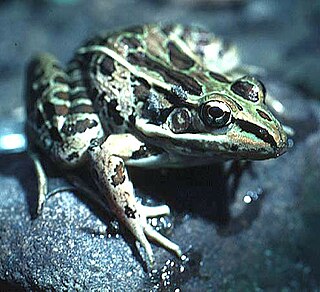 W
WForrer's grass frog or Forrer's leopard frog, Lithobates forreri, is a species of frog in the family Ranidae found in Mexico and Central America through Guatemala, El Salvador, Honduras, and Nicaragua to Costa Rica. It is a widespread and common frog found in lowland and seasonal tropical forests. It can also adapt to man-made habitats such as flooded agricultural lands and other water content systems. Reproduction requires permanent pools and lagoons.
 W
WThe green-and-black poison dart frog, also known as the green-and-black poison arrow frog and green poison frog, is a brightly colored member of the order Anura native to Central America and northwestern parts of South America. This species has also been introduced to Hawaii. It is one of the most variable of all poison dart frogs next to Dendrobates tinctorius and some Oophaga spp. It is considered to be of least concern from a conservation standpoint by the International Union for Conservation of Nature.
 W
WThe Gulf Coast toad is a species of toad native to eastern and southeastern Mexico and Central America as far south as Costa Rica.
 W
WHyalinobatrachium fleischmanni, the Fleischmann's glass frog or northern glass frog, is a species of frog in the family Centrolenidae. It is found in the tropical Americas from southern Mexico to Ecuador. Specifically, these frogs occur in Mexico, Belize, Costa Rica, El Salvador, Guatemala, Honduras, Nicaragua, and Panama, Colombia, and Ecuador. Notice that this and related species have often been confused with each other, and the exact distribution depends on the source.
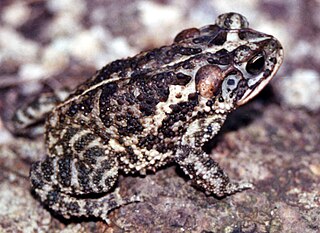 W
WIncilius coccifer is a species of toad in the family Bufonidae. It is found in southern Mexico and southeastward in the Central America through Guatemala, El Salvador, Honduras, and Nicaragua to northwestern Costa Rica. Several species that were formerly included in this species have been named as distinct species: Incilius porteri, Incilius ibarrai, Incilius pisinnus, and Incilius signifer. Its natural habitats are lowland dry and moist forests, and it occurs also in disturbed areas such as pastures, roadside ditches, gardens, and vacant lots in urban areas. It is an abundant and widespread species that is not facing significant threats.
 W
WThe evergreen toad is a species of toad in the family Bufonidae.
 W
WIncilius luetkenii is a species of toad in the family Bufonidae. It is found in the Mesoamerica along the Pacific versant from central Costa Rica to extreme southern Chiapas, Mexico, as well as dry interior valleys of Guatemala and Honduras and San Juan River drainage in Costa Rica on the Atlantic versant. It occurs in open areas, including disturbed pasturelands in lowland dry forest, and to a lesser extent, in lowland moist and premontane moist forests. It breeds in temporary pools. It is a common species that is not facing major threats.
 W
WIncilius melanochlorus, formerly Bufo melanochlorus, is a mid-sized species of toad with a crested head in the family Bufonidae. It is primarily distinguished by its very long first finger with respect to the other fingers. It is found in southern Nicaragua, in the northern Cordillera Central and on the Atlantic slopes of eastern Costa Rica, and in western Panama.
 W
WLeptodactylus bolivianus is a species of frog in the family Leptodactylidae. Its local name is sapo-rana boliviano.
 W
WLeptodactylus fragilis, known under many common names such as the Mexican white-lipped frog, American white-lipped frog or simply white-lipped frog, is a species of leptodactylid frog. Its distribution ranges from the Lower Rio Grande Valley of Texas in the United States south through Mexico and Central America to Colombia and Venezuela. It is often—wrongly—referred to as Leptodactylus labialis (Cope, 1878), which is a junior synonym of Leptodactylus mystacinus.
 W
WLeptodactylus melanonotus is a species of frog in the family Leptodactylidae. It is found in Central America. Its natural habitats are subtropical or tropical dry forests, subtropical or tropical moist lowland forests, subtropical or tropical mangrove forests, subtropical or tropical moist montane forests, dry savanna, moist savanna, subtropical or tropical seasonally wet or flooded lowland grassland, intermittent freshwater lakes, freshwater marshes, intermittent freshwater marshes, pastureland, plantations, rural gardens, urban areas, heavily degraded former forest, water storage areas, ponds, and canals and ditches.
 W
WLeptodactylus savagei, or Savage's thin-toed frog, is a species of leptodactylid frog which ranges from eastern Honduras, through Nicaragua, Costa Rica and Panama to Colombia adjacent to Panama, with a seemingly disjunct population present in the area of Santa Marta in northern Colombia, at elevations from close to the sea level to 660 m (2,170 ft).
 W
WLithobates brownorum is a species of frog native to southern Veracruz and northeastern Oaxaca east through the Yucatan Peninsula and the uplands of Chiapas in southern Mexico through Guatemala and Honduras to Nicaragua. Its separateness from Lithobates berlandieri has been questioned but molecular data now supports the conclusion that it is a separate species.
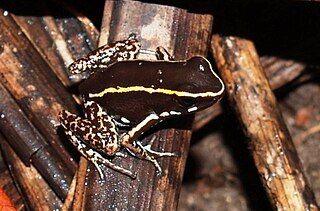 W
WThe lovely poison frog or lovely poison-arrow frog is a species of frog in the family Dendrobatidae. It is found on the Caribbean versant of Central America from southeastern Nicaragua through Costa Rica to northwestern Panama, with one record just west of the Panama Canal. Populations from the Pacific versant, formerly included in this species, are now identified as Phyllobates vittatus.
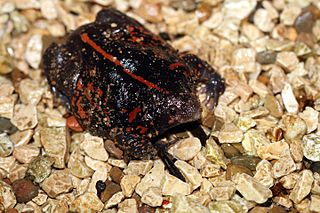 W
WThe Mexican burrowing toad is the only species in the genus Rhinophrynus and the family Rhinophrynidae of order Anura. Their distribution stretches from south Texas through Mexico, Belize, Guatemala, Honduras, and El Salvador to Nicaragua and Costa Rica. R. dorsalis mostly commonly inhabits the subtropical and tropical dry forests within its range characterized by wet and dry seasons, but may also be found during periods of heavy rain in pastures, cultivated field, roadside ditches or other open areas. The family was once more widespread, including species ranging as far north as Canada, but these died out in the Oligocene.
 W
WThe Mexican narrow-mouthed toad is a species of sheep frog native to the Pacific and Caribbean lowlands from southern Texas to Costa Rica. Sheep frogs make a distinctive call that resembles a sheep's bleat during and after rainfall in warm months.
 W
WThe Nicaragua cross-banded tree frog or tawny smilisca, Smilisca puma, is a species of tree frog in the family Hylidae. It is found in the Caribbean lowlands of Costa Rica and adjacent Nicaragua to about 520 m (1,710 ft) above sea level. Its natural habitats are tropical moist lowland forests. It breeds in small, shallow temporary pools or ponds, including those in very disturbed habitats, such as pastures. Males call during the rainy season from shallow water and low bushes. Habitat loss and degradation caused by small- and large-scale agriculture and logging are threats to this species.
 W
WThe Peralta frog, or montane leopard frog, Lithobates taylori, is a species of frog in the family Ranidae found in Costa Rica and Nicaragua.
 W
WThe powdered glass frog or Chiriqui glass frog, Teratohyla pulverata, is a frog species in the glass frog family (Centrolenidae). It is found from north-central Honduras south to northwestern Ecuador.
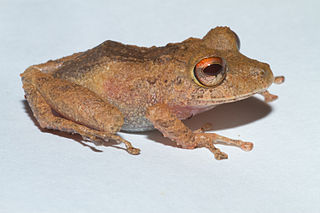 W
WPristimantis cerasinus is a species of frog in the family Craugastoridae. Its common name is Limon robber frog. It is found in Costa Rica, Honduras, Nicaragua, and Panama from sea level to 1,300 m (4,300 ft) asl. Its natural habitats are humid lowland and montane forests. It can sometimes occur on small coffee farms. It is threatened by habitat loss.
 W
WPristimantis ridens, also known as the pygmy rain frog and the Rio San Juan robber frog, is a species of frog in the family Craugastoridae. It is found in western Colombia, and then through Panama and Costa Rica to Nicaragua and eastern Honduras.
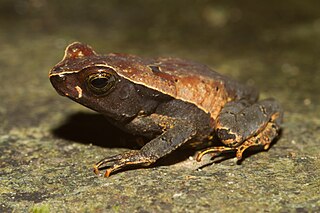 W
WRhaebo haematiticus is a species of toad in the family Bufonidae. It is found in eastern Honduras, Nicaragua, Costa Rica, Panama, Colombia, northwestern Venezuela, and northwestern Ecuador. Its altitudinal range is from sea level to 1,300 m (4,300 ft) asl. Its natural habitats are primary tropical moist forest and submontane humid forest. It is a nocturnal, leaf-litter species that during the breeding seasons is found along small streams and large rivers. It tolerates some habitat degradation but only occurs close to forest. Threats to it are habitat loss caused by agriculture, wood extraction, and cattle ranching, and locally oil pollution and dams.
 W
WThe Rio Grande leopard frog is a species of aquatic frog native to the southern United States in Texas and New Mexico, and south through Mexico and Central America. It is also sometimes referred to as the Mexican leopard frog. The epithet berlandieri is in honor of the naturalist Jean Louis Berlandier, who worked for the Mexican government on one of the first biological surveys of Texas.
 W
WSachatamia ilex is a species of frog in the family Centrolenidae. It is found in eastern Nicaragua, Costa Rica, Panama, western Colombia, and western Ecuador. Common name Limon giant glass frog has been coined for this species, apparently in reference to its type locality in the canton of Limón, Costa Rica, and it is also known as the ghost glass frog.
 W
WScinax boulengeri is a species of frog in the family Hylidae. It is found in Colombia, Costa Rica, Nicaragua, Panama, and possibly Honduras. Its natural habitats are subtropical or tropical moist lowland forests, intermittent freshwater marshes, pastureland, plantations, rural gardens, and urban areas.
 W
WScinax elaeochroa, commonly known as the Sipurio snouted treefrog, or olive snouted treefrog, is a species of frog in the family Hylidae. It is found in the Caribbean lowlands of Nicaragua and Panama and in the Pacific lowlands of Costa Rica and Panama, with an isolated population in Colombia.
 W
WThe strawberry poison frog or strawberry poison-dart frog is a species of small poison dart frog found in Central America. It is common throughout its range, which extends from eastern central Nicaragua through Costa Rica and northwestern Panama. The species is often found in humid lowlands and premontane forest, but large populations are also found in disturbed areas such as plantations. The strawberry poison frog is perhaps most famous for its widespread variation in coloration, comprising approximately 15–30 color morphs, most of which are presumed to be true-breeding. O. pumilio, while not the most poisonous of the dendrobatids, is the most toxic member of its genus.
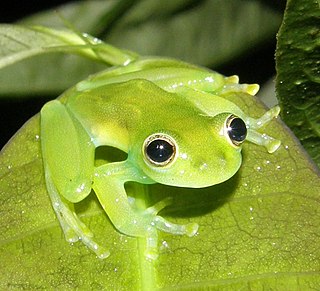 W
WTeratohyla spinosa is a species of frog in the family Centrolenidae. It is found in the Pacific lowlands of northern and central Ecuador and western Colombia, northward on the Pacific slopes Panama and Costa Rica, as well as on the Caribbean slopes of Costa Rica, Nicaragua, and Honduras.
 W
WThe túngara frog is a species of frog in the family Leptodactylidae.
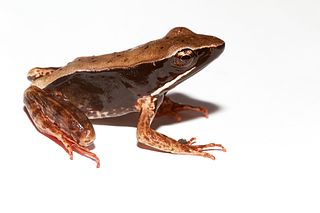 W
WWarszewitsch's frog is a species of frog in the family Ranidae found in Honduras, Nicaragua, Costa Rica, and Panama.